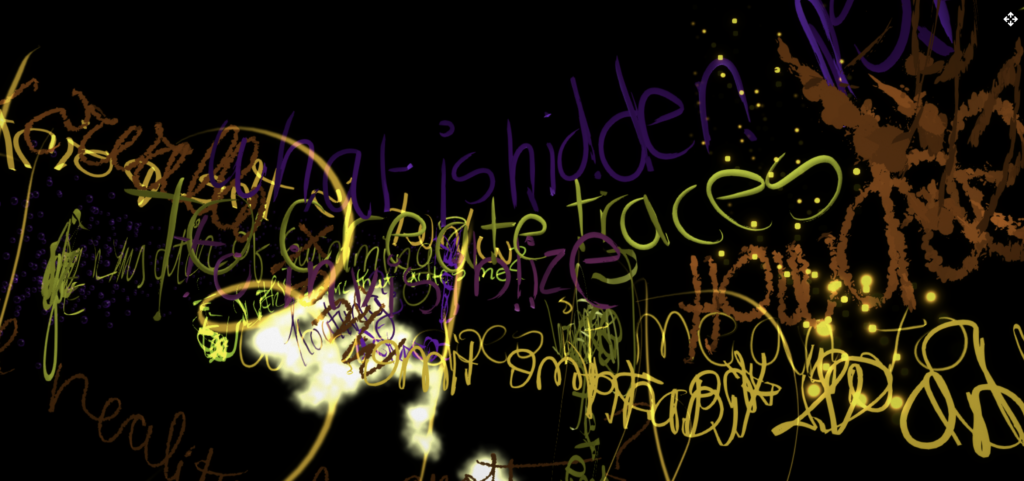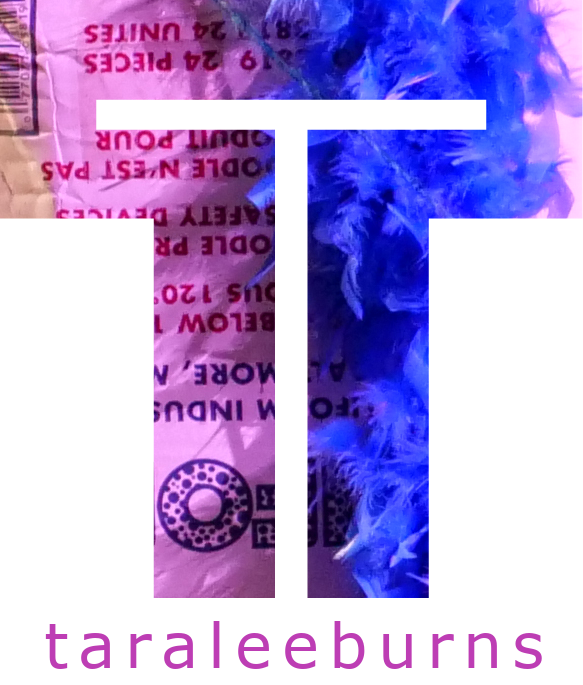
Whether getting lost in time and space as I carve thick paint across a black void, loosing myself in an improvisation only to find I have created a Jackson Pollack, or watching my daughters navigate a virtual landscape with excitement, yelling, “Go toward the pink puffy stuff!” I’m continually amazed at the possibilities for multidisciplinary investigation and nonlinear immersion in Google’s Virtual Reality (VR) painting program Tilt Brush. Through this synthesis, I aim to tease out key themes surrounding cyborgs and identity embedded in my MFA Thesis Tilt World, while also attending to the somatic body inside VR, new trajectories of making in virtual space, and ideas surrounding distribution of my final product. In an attempt to stay in a generative mindset, I have posited questions throughout to spark new investigations.
By repurposing the image of the cyborg body, Donna Haraway means to dissolve the multidisciplinary divide (Haraway 2007) and proposes the dissolution of the dualisms between organism/machine and physical/non-physical (Haraway 2007, 36-37). The physical representation of donning a VR headset can be viewed as prosthesis, a blending of organism/body and machine or cyborg. In Tilt Brush, my augmented human form merges with the black plastic and electronic extensions of my hands and head. Similarly, In Benoît Lachambre’s Is You Me, Louise Lecavalier reorients her clothing (hoodie on face, shoes on backward) to produce something Other and perhaps cyborg (Is You Me, 2011). While I paint nonphysical/virtual lines in Tilt Brush, I also shape the physical space viewed by those watching me. I inhabit a virtual world while colliding with the physical world beneath my feet. Additionally, Tara Chittenden believes, “The virtual becomes an extension of ourselves into Google’s manufactured and constructed space” (Chittenden 2018, 390). In Tilt Brush, the paint extends from your arm similar to a prosthesis, a singular manifestation of the imagination of the artist built in code, and perhaps by extension, a representation of their identity. Haraway’s manifesto informs the conflicts and divisions inherent in my thesis’s central question, what manifests when attending to the body in Tilt Brush’s VR environment?
Addressing the dissemination of product and future delivery of performative art through technology, Expanded Fields, Synchronous Objects, and Improvisation Technologies focus on the coding of choreography and a way of viewing dance through analysis, documentation, and description. The interchangeable pieces of video art, multidisciplinary explorations, and traces past and present are meticulously created through choreographic thought processes and methods but organized into alternative digital performance installations. Through the lens of design, installation, and performance, these works are to web-based performance what Sophy Smith argues is emerging in VR dance performance work in “Dance performance and virtual reality.” Smith states, “…emerging VR dance performance work…draw[s] on the expertise and understanding from traditional live theatre practice [and] is beginning to develop its own language” (Smith 2018, 211). Comparing these digital spaces (VR and web-based) offers making possibilities ranging from interwoven excerpts of film, live-stream, and VR environments to the performance of documentation, traces, and investigations.
Ellen Gerdes uncovers a beautiful breath and intrinsic energy in all movement that is appreciated and nurtured in Chinese philosophy (Gerdes 2010). She highlights the importance behind how the movement is initiated and embodied as a key element in the final outcome of the movement (Gerdes 2010, 237). When dancing I am shifting, controlling, and expelling energy in the states she describes including breath, qi, and flow. She writes of a dancer as both “affecting and affected” (Gerdes 2010, 240). Through my research in Tilt Brush, the painted traces diminish the internal awareness Gerdes is referring to by favoring vision over other senses. Seeing a painted product of your action reduces the ability to internalize movement, breathe, and control the flow of energy and instead brings focus to the outward product. Similarly, Nick Jones believes that our “Cartesian assumptions about (and distortions of) “our daily visual experience” have colonized thinking about space and vision” (Jones 2020, 113). In The Weird Giggle, Ruth Gibson experienced a “kinesthetic bleed-through” (residual experiences that happen outside of the virtual environment) recalling, “I do not breathe enough in there” (Kozel, Gibson, Martelli 2018, 19). While in VR, like most technology, our bodily responses are distracted. How can I reverse these somatic intuitions and include breath and energy initiating an approach of embodied awareness in Tilt Brush? And how would it affect the movement outcome? Going even further, Gerdes also speaks of a specific “circular energy” that connects the dancers to each other and the painted surface in Connect Transfer (Gerdes 2010, 237). Is the virtual paint an extension of energy and/or sensation?
The image of a body wearing a VR headset evokes science-fiction, cyborg, and Other. However, by connecting drawing with my identity as a dancer, mother, and woman the image of cyborg is disrupted to include the metaphor Haraway demands. By repurposing old making techniques for virtual spaces, I aim to build a series of short interchangeable works in a range of disciplines and further imagine the possibilities of non-traditional venues. Chittenden describes painting through the lens of Bakhtin’s chronotope as “a canvas-unbound.” In the black infinite space of Tilt Brush with my unlimited imagination, time and space disappear, so perhaps I am the canvas-unbound and my final product, a collection of investigations.
Bibliography
Chittenden, Tara. 2018. “Tilt Brush painting: Chronotropic adventures in a physical-virtual threshold.” In Journal of Contemporary Painting 4. No. 2, 381-403. http:dx.doi.org.proxy.lib.ohio-state.eud/10.1386/jcp.4.2.381_1.
Forsythe, William. William Forsythe: Improvisation Technologies: A Tool for the Analytical Dance Eye. Hatje Cantz: Multimedia, 2010. CD-ROM.
Forsythe, William, Maria Palazzi, Norah Zuniga Shaw. 2000. Synchronous Objects. Website Installation. https://synchronousobjects.osu.edu/.
Gerdes, Ellen V. P. 2010. “Shen Wei Dance Arts: Chinese Philosophy in Body Calligraphy.” In Dance Chronicle 33. No. 2: 231-250. https://www.jstor.org/.
Gibson, Ruth and Bruno Martelli. 2019. “Expanded Fields.” http://gibsonmartelli.com/ portfolio/expanded-fields.
Haraway, Donna. 2007. “A Cyborg Maifesto: Science, technology and socialist-feminism in the late twentieth century.” In The Cybercultures Reader 2nd Edition, edited by David Bell and Barbara M. Kennedy, 34-60. London and New York: Routledge.
Jones, Nick. 2020. “Immersion.” In Spaces Mapped and Monstrous: Digital 3D Cinema and Visual Culture, 92 – 114. https://www.jstor.org/stable/10.7312/jone19422.10.
Kozel, Susan, Ruth Gibson, Bruno Martelli. 2018. “The Weird Giggle: Attending to Affect in Virtual Reality.” In Transformations 31. http://www.transformationsjournal.org.
Lachambre, Benoît. “Is You Me.” Medici TV. Video File. 2011. https://edu-medici-tv.proxy.lib.ohio-state.edu/en/ballets/is-you-me-goldring-lachambre-lecavalier-rowe-legay/.
Gibson, Ruth and Bruno Martelli. “MAN A VR.” Youtube. 2016. https://www.youtube.com/watch?v=45BOhBSF_U4&feature=youtu.be.
Shen Wei Dance Arts. 2004. “Connect Transfer.” American Dance Festival Archive, recorded by Caroline Woodward, choreography by Shen Wei; Durham, NC: ADF Archive, DVD.
